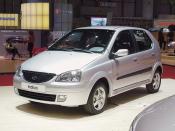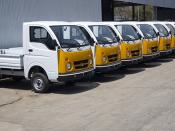Company Background:
Profile.
Tata Motors is India's foremost, and only fully integrated, automobile manufacturer. Established in 1945 as the Tata Engineering and Locomotive Company to manufacture locomotives and other engineering products, the company is today among the world's top 10 producers of commercial vehicles.
Tata Motors, previously known as Tata Engineering, is one of the biggest and most prominent companies in the Tata Group, with an annual turnover of US$ 1.8 billion in 2001-02.
Area of Business
Tata Motors' product range covers passenger cars, multi-utility vehicles and light, medium and heavy commercial vehicles for goods and passenger transport. Seven out of 10 medium and heavy commercial vehicles in India bear the trusted Tata mark.
The Indica V2 -- India's first indigenously designed and manufactured passenger car -- has been a phenomenal success, standing testimony to the company's research and engineering expertise. Tata Motors followed this up with the launch in 2002 of the Indigo, a sedan.
The company enjoys a significant demand in export markets such as Europe, Australia, South East Asia, the Middle East and Africa. Tata Motors vehicles currently sell in over 70 countries.
The Passenger Car Industry:
The global car industry is estimated to be valued at around 38mn cars and US$700bn in value. The highly penetrated markets of US, Europe and Japan have witnessed a slowdown in demand growth during the last three years due to economic slowdown. Most auto majors globally have therefore set their sight on the low penetrated markets in developing economies.
Global Penetration statistics
Country Cars per thousand population
USA 800
Japan 700
Bangladesh 14
Sri Lanka 12
India 7
As it's clear from the above pie chart, Tata Indica (shown as Telco) in the figure has a share of 11.5%.
The Indian Passenger Car Industry in the Financial Year 2002-03:
As we know Tata Indica falls in the Segment B and segment B has a total sales of 357292 and has a market share of 53%, higher than any other segment. Telco has a installed capacity of 160000 and utilization of 58%.
Strength and Weaknesses of the Major Players in Segment B
1. Hyundai - Santro.
Hyundai's performance in India has not been entirely blemishless. The company did not bring its latest engine technology to India and unlike rival Daewoo, could offer its Euro II2 compliant versions only at a higher price. In the process, the company's image took a beating. Hyundai also miscalculated the demand for the Santro. When demand peaked, customers had to wait for three months. Hyundai has now embarked on a capacity expansion project at its plant in Sriperambadur in Madras. The investment of around $400 million will take the capacity from 120,000 cars to 200,000 by December 2001.
Strengths
- More headroom
- excellent advertising campaign
- innovative design
- competitively priced.
Weakness
- Initially perceived as an unconventional design.
- General substandard perception of Korean products.
- Limited dealer network.
MUL.
In the 1980s, India's top politicians felt the need to produce a small car which would be within the buying reach of the Indian middle class. The obvious place to shop for technology was Japan which had developed world class capabilities in small cars by this time. It was not Toyota or Nissan or Honda, the three largest players in Japan, with whom the Indian Government tied up, but Suzuki, a much smaller company. Suzuki's small car capabilities probably influenced this decision.
Strengths:
- Brand name Maruti
- Oldest most well established company
- Joint Venture with Suzuki motors
- Ergonomic design
- Best resale value as per recent market surveys
- Technically superior
- Wide range of variants
Weaknesses:
- Dated design
- Lack of headroom, luggage space
- Metal gauge used is very less (weak body structure)
Price Comparison Between Tata Indica and Hyundai Santro:
Tata IndicaLEi LXi Hyundai SantroL2 LE
Delhi 3,50,602 4,34,767 3,22,319 3,60,999
Mumbai 3,44,034 4,28,261 3,66,559 3,64,557
Calcutta 3,52,555 4,36,630 3,19,904 3,48,793
Chennai 3,35,635 4,22,902 3,28,820 3,29,856
Bangalore 3,60,935 4,48,893 3,55,250 3,29,856
SWOT Analysis of the Brand - Tata Indica
Strengths:
1. Huge Investment in R & D
Tata Motors invests up to 1.3 per cent of its annual turnover on research and development. It has set up two in-house engineering research centres, including India's only certified crash-test facility. The company has been implementing several environmentally sensitive technologies in manufacturing processes, and uses some of the world's most advanced equipment for emission checking and control.
2.Environmental responsibility:
Tata Motors has led the Indian automobile industry's anti-pollution efforts by introducing cleaner engines. It is the first Indian company to introduce vehicles with Euro I and Euro II norms. Its joint venture with Cummins Engine Company, USA, in 1992 was a pioneering effort to introduce emission control technology in India.
Tata Motors has set up effluent treatment facilities to avoid release of polluted water into the environment. In Pune the treated water is conserved in lakes that attract various species of birds from around the world, thus turning the space into a green belt.
The company's endeavours in environment protection include soil- and water-conservation programmes and extensive tree plantation drives.
They have enjoyed a near-monopoly situation in the 'affordable and economical to run diesel' segment and it was about time they took their petrol powered car seriously. Look at it this way, how could they let Fiat walk away with a brilliant new market segment of big engined petrol powered hatcheswhen they had an automobile that was designed by the same firm (I.de.A), that designed the Palio?
There is no substitute to cubic capacity, and the Indica's 1400 CC might was enough to humble, if not humiliate, the smaller-engined Palio. The Indica manages 75 bhp at 5500 rpm as compared to the 72 horses the Palio 1.2 develops at 6000 clicks. That's an indication of the apparent difference, but to get a better idea, let us take these cars through the gears and get some serious numbers.
The Indica is quick off the block and achieved the 0-to-60 kph run in just 5.97 seconds, while the Palio took all of 7.33 seconds to get there.
3. The Indica 2000 comes with all the associated benefits of more space, more style, more safety, and more features. The interiors have a sporty feel with a white instrument panel and a dual-tone centre console. Brighter upholstery complements the car's plush interiors.
Weaknesses.
1. All the upgrades and new offerings made the Indica look ante-diluvian. Where all new offerings followed Euro II norms and introduced multi-point fuel injection (MPFI) engines, the petrol Indica was the only new small car to be run on carburrettors. This was rectified in May 2000 when the company launched the Indica 2000 which an MPFI engine.
2. Negative publicity.
After an initial run of a year, some of the earlier Indicas to hit the road had thrown up problems like uneven tyre wear, belt noise and other related problems. Customer complaints led to a image downgrade.
3. Increase in price when other companies decreased it.
Opportunities:
- Huge market yet to be exploited.
- Target the export market, particularly Asia.
- Adoption of cost reducing techniques.
- Expand market base in India after disinvestment of Maruti Udyog.
Threats:
- To tackle quality-related issues.
- To speedily come out with variants.
- Competitors are coming up with multi-variant cars.
- Change in tax-reforms (sales tax) - sales tax was increased from 6% - 12%.
- Increasingly stringent environmental and safety standards will place even heavier financial and technical burdens on participants.
Environmental Factors Affecting Tata Indica:
Political and Legal:
Indica sales suffered in 2000 due to the sales tax adjustments. For instance, as the sales tax was increased in May 2001 from 6 per cent to 12 per cent in the northern and western states (which contribute to nearly 60 per cent of the total cars sold in the country), the industry saw aggressive pricing strategies implemented by each manufacturer.
After disinvestment of Maruti Udyog, Tata Indica sales have rose by 3%.
Technological:
As technology changes day by day, Tata Indica has to upgrade itself to remain successful in this competitive environment.
Demographic Factors:
As generation changes, people want more fashionable and funky cars.
As family size is decreasing day by day, people have started going for cars that are small in size.
More and more females have started working in organizations, the demand of cars have increased.
Geographic:
Due to parking problems in metros and major cities, people have started liking compact cars.
Psychographic:
Today lifestyle plays major role, when people think of buying a car. Their brand depends on the life-style whether it's culture-oriented or sports oriented.
Behavioral:
When people go for a car, they try to extract what benefits they are going to extract from that car in terms of quality, service, economy and speed.
Refrences:
÷ www.icfai.org/icpe/study@icfai/jan03/34_JAN.htm
÷ cars.tatamotors.com/sitemap.asp
÷ cars.telcoindia.com/insurance.asp
÷ www.carrentals-india.com/indica-tata-mid-size-small-car-rentals-india-reservation.html


